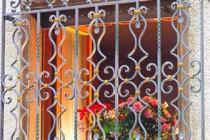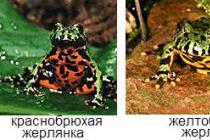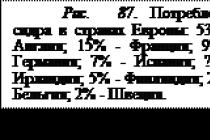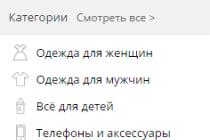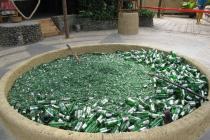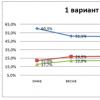Exercise
For a steel shaft with a circular cross section, determine the values of external moments corresponding to the transmitted powers, and the balanced moment (Table 7.1 and Table 7.2).
Plot the torque curve along the length of the shaft.
Determine the shaft diameters by sections based on strength and stiffness calculations. Round the higher result to the nearest even number or number ending in 5.
When calculating, use the following data: the shaft rotates at an angular velocity of 25 rad/s; shaft material - steel, allowable torsion stress 30 MPa, modulus of elasticity in shear 8 10 4 MPa; permissible angle of twist = 0.02 rad/m.
Carry out the calculation for the shaft of the annular section, taking With= 0.9. Draw conclusions about the feasibility of making a shaft with a round or annular section by comparing the cross-sectional areas.
Goal of the work - learn how to perform design and verification calculations for round beams for statically determinate systems, to test for stiffness.
Theoretical justification
Torsion is called loading, in which only one internal force factor arises in the cross section of the beam - torque. External loads are also two oppositely directed pairs of forces.
Distribution of shear stresses over the cross section during torsion (Fig. 7.1)
Shear stress at a point A:

Fig.7.1
 (7.1)
(7.1)
where is the distance from the point A before
section center.
Torsional strength condition
![]() ;
; ![]() (circle), (7.2)
(circle), (7.2)
![]() (ring), (7.3)
(ring), (7.3)
where M to - torque in the section, N-m, N-mm;
Wp- moment of resistance during torsion, m 3, mm 3;
[t to] - allowable torsional stress, N / m 2, N / mm 2.
Design calculation, determination of cross-section dimensions
 (7.4)
(7.4)
Where d- outer diameter of circular section;
dBn- inner diameter of the annular section; c \u003d d BK / d.
Determining the rational arrangement of the wheel shaft
A rational arrangement of wheels is an arrangement in which the maximum value of the torque on the shaft is the smallest possible.
Torsional stiffness condition
; G ≈ 0.4E(7.5)
Where G- modulus of elasticity in shear, N/m 2 , N/mm 2 ;
E- tensile modulus, N/m 2 , N/mm 2 .
[φo] - permissible angle of twist, [φо] = 0.54-1 deg/m;
Jp- polar moment of inertia in the section, m 4 , mm 4 .
 (7.6) (7.6)
|
Design calculation, determination of the outer diameter of the section
Work order
1. Construct a diagram of torques along the length of the shaft for the scheme proposed in the task.
2. Choose a rational arrangement of wheels on the shaft and carry out further calculations for a shaft with rationally located pulleys.
3. Determine the required diameters of the round shaft based on strength and rigidity and choose the largest of the obtained values by rounding the diameter.
4. Compare metal costs for the case of round and annular sections. Comparison is carried out according to the cross-sectional areas of the shafts.
1. What deformations occur during torsion?
2. What hypotheses are fulfilled under torsion deformation?
3. Do the length and diameter of the shaft change after twisting?
4. What internal force factors arise during torsion?
5. What is the rational arrangement of ears on the shaft?
6. What is the polar moment of inertia? What is the physical meaning of this quantity?
7. In what units is it measured?
Execution example
For a given bar (Fig. 7.1), plot torque diagrams, by rational arrangement of pulleys on the shaft, achieve a decrease in the value of the maximum torque. Construct a diagram of torques with a rational arrangement of pulleys. From the strength condition, determine the diameters of the shafts for solid and annular sections, taking c = . Compare the obtained results by the obtained cross-sectional areas. [τ] = 35 MPa.
Solution
cross section 2 (Fig. 7.2b):
cross section 3 (Fig. 7.3c):

Fig.7.2

A B C
Fig.7.3
- We build a diagram of torques. We set the values of torques down from the axis, because points are negative. The maximum value of the torque on the shaft in this case is 1000 Nm (Fig. 7.1).
- Let's choose a rational arrangement of pulleys on the shaft. It is most expedient to place the pulleys in such a way that the largest positive and negative torque values in the sections will be as equal as possible. For these reasons, the drive pulley transmitting a torque of 1000 Nm is placed closer to the center of the shaft, the driven pulleys 1 and 2 are placed to the left of the drive with a torque of 1000 Nm, pulley 3 remains in the same place. We build a torque diagram for the selected location of the pulleys (Fig. 7.3).
The maximum value of the torque on the shaft with the selected location of the pulleys is 600 N * m.

Fig.7.4
Torsional moment:
![]()
![]()
![]()
We determine the diameters of the shaft according to the sections:
![]()
![]()
![]()
![]()
We round the obtained values: , ,
- We determine the shaft diameters by sections, provided that the section is a ring
The moments of resistance remain the same. By condition
Polar moment of resistance of the ring: ![]()
Formula for determining the outer diameter of an annular shaft:

The calculation can be carried out according to the formula: 
Shaft diameters by sections:
![]()
![]()
![]()
The outer diameters of the shaft of the annular section have not changed.
For an annular section: , ,
- To conclude that metal is saved, when switching to an annular section, we compare the cross-sectional areas (Fig. 7.4)
Provided that the section is a circle (Fig. 7.4a)
Solid round section:
![]()
![]()
![]()
Provided that the section is a ring, (Fig. 7.4b)
![]()
Annular section:
![]()
![]()
![]()
Comparative evaluation of results:
![]()
Consequently, when switching from a circular to an annular section, the metal savings by weight will be 1.3 times.

fig.7.4
Table 7.1
 |  |  |
 |  |  |
 |  |  |
 |
Table 7.2
| Option | Options | |||
| a = b = s, m | P1, kW | P2, kW | P3, kW | |
| 1,1 | 2,1 | 2,6 | 3,1 | |
| 1,2 | 2,2 | 2,7 | 3,2 | |
| 1,3 | 2,3 | 2,8 | 3,3 | |
| 1,4 | 2,4 | 2,9 | 3,4 | |
| 1,5 | 2,5 | 3,0 | 3,5 | |
| 1,6 | 2,6 | 3,1 | 3,6 | |
| 1,7 | 2,7 | 3,2 | 3,7 | |
| 1,8 | 2,8 | 3,3 | 3,8 | |
| 1,9 | 2,9 | 3,4 | 3,9 | |
| 2,0 | 3,0 | 3,5 | 4,0 | |
| 1,1 | 3,1 | 3,4 | 4,1 | |
| 1,2 | 3,2 | 3,3 | 4,2 | |
| 1,3 | 3,3 | 3,2 | 4,3 | |
| 1,4 | 3,4 | 3,1 | 4,5 | |
| 1,5 | 3,5 | 2,8 | 2,9 | |
| 1,3 | 2,1 | 2,6 | 3,1 | |
| 1,4 | 2,2 | 2,7 | 3,2 | |
| 1,5 | 2,3 | 2,8 | 3,3 | |
| 1,6 | 2,4 | 2,9 | 3,4 | |
| 1,7 | 2,5 | 3,0 | 3,5 | |
| 1,8 | 2,6 | 3,1 | 3,6 | |
| 1,9 | 2,7 | 3,2 | 3,7 | |
| 2,0 | 2,8 | 3,3 | 3,8 | |
| 1,1 | 2,9 | 3,4 | 3,9 | |
| 1,2 | 3,0 | 3,5 | 4,0 | |
| 1,3 | 3,1 | 3,4 | 4,1 | |
| 1,4 | 3,2 | 3,3 | 4,2 | |
| 1,5 | 3,3 | 3,2 | 4,3 | |
| 1,4 | 3,4 | 3,1 | 4,5 | |
| 1,9 | 3,5 | 2,8 | 2,9 |
APPENDIX A
Torsion of a round bar - condition of the problem
Four external torsional moments are applied to a steel shaft of constant cross section (Fig. 3.8): kN m; kN m; kN m; kN m Lengths of sections of the rod: m; m, m, m. Required: plot the torques, determine the shaft diameter at kN/cm2 and plot the twist angles of the rod cross sections.
Torsion of a round bar - design scheme
 Rice. 3.8
Rice. 3.8
Solution of the problem of torsion of a round rod
Determine the reactive moment that occurs in a rigid termination
Let us designate the moment in the embedding and direct it, for example, counterclockwise (when looking towards the z axis).
Let us write the balance equation for the shaft. In doing so, we will use next rule signs: external torsional moments (active moments, as well as a reactive moment in the termination), rotating the shaft counterclockwise (when looking at it towards the z axis), we consider positive.
The plus sign in the expression we received indicates that we guessed the direction of the reactive moment that occurs in the termination.
We build a diagram of torques
Recall that the internal torque that occurs in a certain cross section of the rod is equal to the algebraic sum of the external torsional moments applied to any of the parts of the rod under consideration (that is, acting to the left or to the right of the section made). In this case, the external torsional moment, which rotates the considered part of the rod counterclockwise (when looking at the cross section), is included in this algebraic sum with a plus sign, and along the way with a minus sign.
Accordingly, the positive internal torque, which counteracts the external torsional moments, is directed clockwise (when looking at the cross section), and the negative one is counterclockwise.
We divide the length of the rod into four sections (Fig. 3.8, a). The boundaries of the sections are those sections in which external moments are applied.
We make one section in an arbitrary place of each of the four sections of the rod.
Section 1 - 1. Mentally discard (or cover with a piece of paper) left side rod. To balance the torsional moment kN m, an equal and oppositely directed torque must occur in the cross section of the rod. Taking into account the sign rule mentioned above
![]() kN m
kN m
Sections 2 - 2 and 3 - 3:
Section 4 - 4. To determine the torque, in section 4 - 4 we discard the right side of the rod. Then
![]() kN m
kN m
It is easy to verify that the result obtained will not change if we discard now not the right, but the left part of the rod. Get
To plot the torque diagram, we draw an axis parallel to the axis of the rod z with a thin line (Fig. 3.8, b). The calculated values of torques in the selected scale and taking into account their sign are set aside from this axis. Within each section of the rod, the torque is constant, so we kind of “shade” the corresponding section with vertical lines. Recall that each segment of the “hatching” (the ordinate of the diagram) gives, on the accepted scale, the value of the torque in the corresponding cross section of the rod. The resulting plot is outlined with a bold line.
Note that in the places where external torsional moments are applied on the diagram, we have obtained an abrupt change in the internal torque by the value of the corresponding external moment.
Determine the shaft diameter from the strength condition
The torsion strength condition has the form
 ,
,
Where ![]() - polar moment of resistance (torsional moment of resistance).
- polar moment of resistance (torsional moment of resistance).
The highest absolute torque occurs in the second section of the shaft: ![]() kN cm
kN cm
Then the required shaft diameter is determined by the formula
 cm.
cm.
Rounding the obtained value to the standard, we take the shaft diameter equal to mm.
Determine the twist angles of cross sections A, B, C, D, and E and plot the twist angles
First, we calculate the torsional stiffness of the rod , where G is the shear modulus, and ![]() is the polar moment of inertia. Get
is the polar moment of inertia. Get
The angles of twist in individual sections of the rod are equal to:
 glad;
glad;
 glad;
glad;
 glad;
glad;
 glad.
glad.
The angle of twist in the termination is zero, that is, . Then
The plot of twist angles is shown in fig. 3.8, c. Note that within the length of each section of the shaft, the angle of twist changes linearly.
An example of a torsion problem for a "round" rod for an independent solution
Condition of the problem on torsion of a "round" rod
A steel rod rigidly clamped at one end (shear modulus kN / cm2) of a circular cross section is twisted by four moments (Fig. 3.7).
Required:
construct a diagram of torques;
· at a given allowable shear stress kN/cm2 from the strength condition determine the diameter of the shaft, rounding it to the nearest of the following values 30, 35, 40, 45, 50, 60, 70, 80, 90, 100, 200 mm;
· plot the angles of twisting of the cross sections of the rod.
Variants of design schemes for the problem of torsion of a round bar for independent solution

An example of a round rod torsion problem - initial conditions for an independent solution
| Scheme number | ||||||||
|
5.1 (Option 08)
Instructions: take the power on the gear wheels as P 2 = 0.5 P 1, P 3 = 0.3 P 1 and P 4 = 0.2 P1. The resulting calculated value of the diameter (in mm) is rounded up to the nearest higher number ending in 0, 2, 5, 8 or ST SEV 208-75 [τ]=30 MPa.
Table 20 - Initial data
| task number and diagrams in Fig. 35 | R, kW | ω, rad/s | Distance between pulleys, m | ||
| l 1 | l 2 | l 3 | |||
| 100,X | 28 | 26 | 0,2 | 0,1 | 0,3 |
Answer: d 1 = 45.2 mm, d 2 = 53.0 mm, d 3 = 57.0 mm, φ I = 0.283º, φ II = 0.080º, φ III = 0.149º.
5.2
d) determine the shaft diameter, assuming [σ]=60 N/mm² (in problem 117) and setting F r =0.4F t . In problem 117, the calculation is carried out according to the hypothesis of the largest shear stresses. 
Table 22 - Initial data
| task number and diagrams in Fig. 37 | Option | R, kW | ω 1, rad/s |
| 117, VII | 08 | 8 | 35 |
Answer: R By =7145 H, R Ay =3481 H, d=51 mm.
5.3 For a steel shaft of constant cross section (Fig. 7.17), transmitting power P (kW) at an angular velocity ω (rad / s) (take the numerical values \u200b\u200bof these quantities for your version from Table 7.4):
a) determine the vertical and horizontal components of the bearing reaction;
b) plot torques;
c) build diagrams of bending moments in the vertical and horizontal planes;
d) determine the diameter of the shaft, taking [σ]=70 MPa (in problems 41, 43, 45, 47, 49) or [σ]=60 MPa (in problems 42, 44, 46, 48, 50). For forces acting on the gear wheel, take F r =0.36F t , for belt tension S 1 =2S 2 . In tasks 42, 44, 46, 48, 50, the calculation is carried out according to the hypothesis of the potential energy of deformation, and in tasks 41, 43, 45, 47, 49, according to the hypothesis of the greatest shear stresses. 
Table 22 - Initial data
| Task number and diagrams in Fig. 7.17 | Option | R, kW | ω, rad/s |
| Problem 45, Diagram V | 47 | 30 | 24 |
Answer: R By =4000 H, R Ay =14000 H, d=64 mm.
5.4 For one of the schemes (Fig. 35, Table 20) construct a diagram of torques; determine the shaft diameter at each section and the total angle of twist.
Instructions: take the power on the gears P 2 = 0.5 R 1, R 3 = 0.3 R 1 and R 4 = 0.2 R 1. The resulting calculated value of the diameter (in mm) is rounded up to the nearest higher number ending in 0, 2, 5, 8 or ST SEV 208-75 [τ]=30 MPa. 
Table 20
| No. of the task and scheme in Fig. 35 | Option | R, kW | ω, rad/s | Distance between pulleys, m | ||
| l 1 | l 2 | l 3 | ||||
| 91,I | 29 | 20 | 30 | 0,2 | 0,9 | 0,4 |
Answer: d 1 = 28.5 mm, d 2 = 43.2 mm, d 3 = 48.5 mm, φ I = 0.894º, φ II = 0.783º, φ III = 0.176º.
5.5 For a steel shaft of constant cross section with one gear (Fig. 37), transmitting power P (kW) at an angular velocity ω 1 (rad / s) (take the numerical values \u200b\u200bof these quantities for your version from Table 22):
a) determine the vertical and horizontal components of the bearing reaction;
b) plot torques;
c) build diagrams of bending moments in the vertical and horizontal planes;
d) determine the diameter of the shaft, assuming [σ]=70 N/mm² (in problem 112) and setting F r =0.4F t . In problem 112, the calculation is carried out according to the hypothesis of the potential energy of shape change. 
Table 22
| No. of the task and scheme in Fig. 37 | Option | R, kW | ω 1, rad/s |
| 112 II | 29 | 20 | 50 |
Answer: R By =1143 H, R Ay =457 H, d=40.5 mm.
Select the dimensions of the cross section of the shaft (Fig. 1) according to the strength condition. In sections from section 1 to section 3 and from section 5 to section 6, the outer diameter of the shaft, for structural reasons, must have the same size.
In the area from section 1 to section 2, the shaft has an annular cross section with n=d B /d=0.4. In sections from section 3 to section 5, the shaft is selected only according to the strength condition.
M = 1 kN∙m, [τ] = 80 MPa.
Solution
We divide the shaft into power sections , build a torque diagram (Fig. 1, b).
Determine the shaft diameter. On sections I, II and V, the outer diameter of the shaft is the same. For them, it is not possible to specify in advance the section with the highest value of shear stress, since different sections have Various types cross-section: I section - annular, II and V - solid round.
It is necessary to determine separately, according to the strength condition, the diameters for each type of cross section for the most loaded power section (that is, the one on which the maximum torque in absolute value acts). Finally, we accept the largest diameter obtained.
For a section with an annular section:
For solid shaft

Finally, we accept the largest value of the resulting diameter, rounded up to an integer value:
d 1 = d 2 = d 5 = 61 mm;
d B1 = n∙d 1 = 0.4∙61 = 24.4 mm.
The highest voltage acting on these sections:
Shaft diameter in section III (M K3 = 5M = 5 kNm).
Example 1 Based on strength and stiffness calculations, determine the required shaft diameter for power transmission of 63 kW at a speed of 30 rad/s. Shaft material - steel, allowable torsional stress 30 MPa; permissible relative angle of twist [φ o ]= 0.02 rad/m; shear modulus G= 0.8 * 10 5 MPa.
Solution
1. Determining the dimensions of the cross section based on strength.
Torsional strength condition:
We determine the torque from the power formula during rotation:
From the strength condition, we determine the moment of resistance of the shaft during torsion
We substitute the values in newtons and mm.
Determine the shaft diameter:
2. Determining the dimensions of the cross section based on stiffness.
Torsional stiffness condition:
From the stiffness condition, we determine the moment of inertia of the section during torsion:
Determine the shaft diameter:
3. Selection of the required shaft diameter based on strength and rigidity calculations.
To ensure strength and rigidity, we choose the larger of the two found values simultaneously.
The resulting value should be rounded off using a range of preferred numbers. We practically round off the obtained value so that the number ends with 5 or 0. We take the value d of the shaft = 75 mm.
To determine the shaft diameter, it is desirable to use the standard range of diameters given in Appendix 2.
Example 2 In the cross section of the beam d= 80 mm maximum shear stress τ max\u003d 40 N / mm 2. Determine the shear stress at a point 20 mm away from the center of the section.
Solution
b. Obviously,
Example 3 At the points of the inner contour of the pipe cross section (d 0 = 60 mm; d = 80 mm), shear stresses equal to 40 N/mm 2 arise. Determine the maximum shear stresses that occur in the pipe.
Solution
The diagram of tangential stresses in the cross section is shown in fig. 2.37 V. Obviously,
Example 4 In the annular cross section of the beam ( d0= 30 mm; d= 70 mm) torque occurs Mz= 3 kN-m. Calculate the shear stress at a point 27 mm away from the center of the section.
Solution
Shear stress at an arbitrary point of the cross section is calculated by the formula
In this example Mz= 3 kN-m = 3-10 6 N mm,
![]()
Example 5 Steel pipe(d 0 = l00 mm; d = 120 mm) length l= 1.8 m torque T applied in its end sections. Determine the value T, at which the angle of twist φ = 0.25°. With the found value T calculate the maximum shear stresses.
Solution
The angle of twist (in deg/m) for one section is calculated by the formula
In this case
Substituting numerical values, we get
We calculate the maximum shear stresses:

Example 6 For a given beam (Fig. 2.38, A) build diagrams of torques, maximum shear stresses, angles of rotation of cross sections.
Solution
A given beam has sections I, II, III, IV, V(Fig. 2. 38, A). Recall that the boundaries of the sections are sections in which external (twisting) moments and places of change in the dimensions of the cross section are applied.
Using the relation
![]()
we build a diagram of torques.
Plotting Mz we start from the free end of the beam:
![]()
for plots III And IV
for the site V
The diagram of torques is shown in Fig. 2.38, b. We build a diagram of the maximum tangential stresses along the length of the beam. We conditionally attribute τ check the same signs as the corresponding torques. Location on I
Location on II
Location on III
Location on IV
Location on V

The plot of maximum shear stresses is shown in fig. 2.38 V.
The angle of rotation of the cross section of the beam at a constant (within each section) diameter of the section and torque is determined by the formula
![]()
We build a diagram of the angles of rotation of the cross sections. Section rotation angle A φ l \u003d 0, since the beam is fixed in this section.
The diagram of the angles of rotation of the cross sections is shown in fig. 2.38 G.
Example 7 per pulley IN stepped shaft (Fig. 2.39, A) power transferred from the engine N B = 36 kW, pulleys A And WITH respectively transferred to the power machines N A= 15 kW and N C= 21 kW. Shaft speed P= 300 rpm. Check the strength and rigidity of the shaft, if [ τ K J \u003d 30 N / mm 2, [Θ] \u003d 0.3 deg / m, G \u003d 8.0-10 4 N / mm 2, d1= 45 mm, d2= 50 mm.
Solution
Let us calculate the external (twisting) moments applied to the shaft:
![]()
We build a diagram of torques. At the same time, moving from the left end of the shaft, we conditionally consider the moment corresponding to N A, positive Nc- negative. The diagram M z is shown in fig. 2.39 b. Maximum stresses in the cross sections of section AB
which is less [t k ] by
Relative angle of twist of section AB
which is much more than [Θ] ==0.3 deg/m.
Maximum stresses in the cross sections of the section Sun
which is less [t k ] by
Relative twist angle of the section Sun

which is much more than [Θ] = 0.3 deg/m.
Consequently, the strength of the shaft is ensured, but the rigidity is not.
Example 8 From the motor with a belt to the shaft 1 transmitted power N= 20 kW, From the shaft 1 enters the shaft 2 power N 1= 15 kW and to working machines - power N 2= 2 kW and N 3= 3 kW. From the shaft 2 power is supplied to the working machines N 4= 7 kW, N 5= 4 kW, No. 6= 4 kW (Fig. 2.40, A). Determine the diameters of the shafts d 1 and d 2 from the condition of strength and stiffness, if [ τ K J \u003d 25 N / mm 2, [Θ] \u003d 0.25 deg / m, G \u003d 8.0-10 4 N / mm 2. Shaft sections 1 And 2 be considered constant over the entire length. Motor shaft speed n = 970 rpm, pulley diameters D 1 = 200 mm, D 2 = 400 mm, D 3 = 200 mm, D 4 = 600 mm. Ignore slip in the belt drive.
Solution
Fig. 2.40 b the shaft is shown I. It receives power N and power is removed from it N l, N 2 , N 3 .
Determine the angular velocity of rotation of the shaft 1 and external torsional moments



